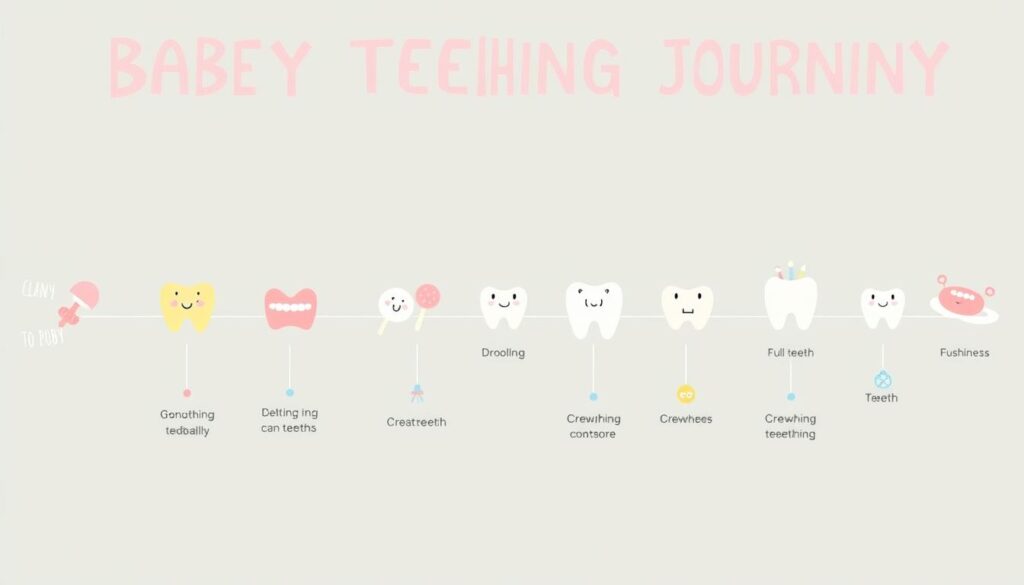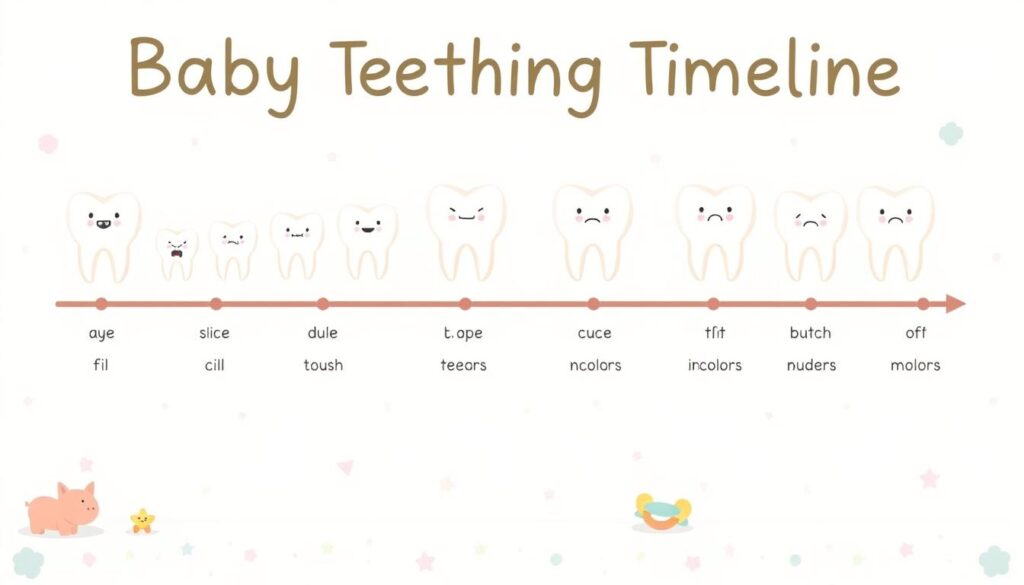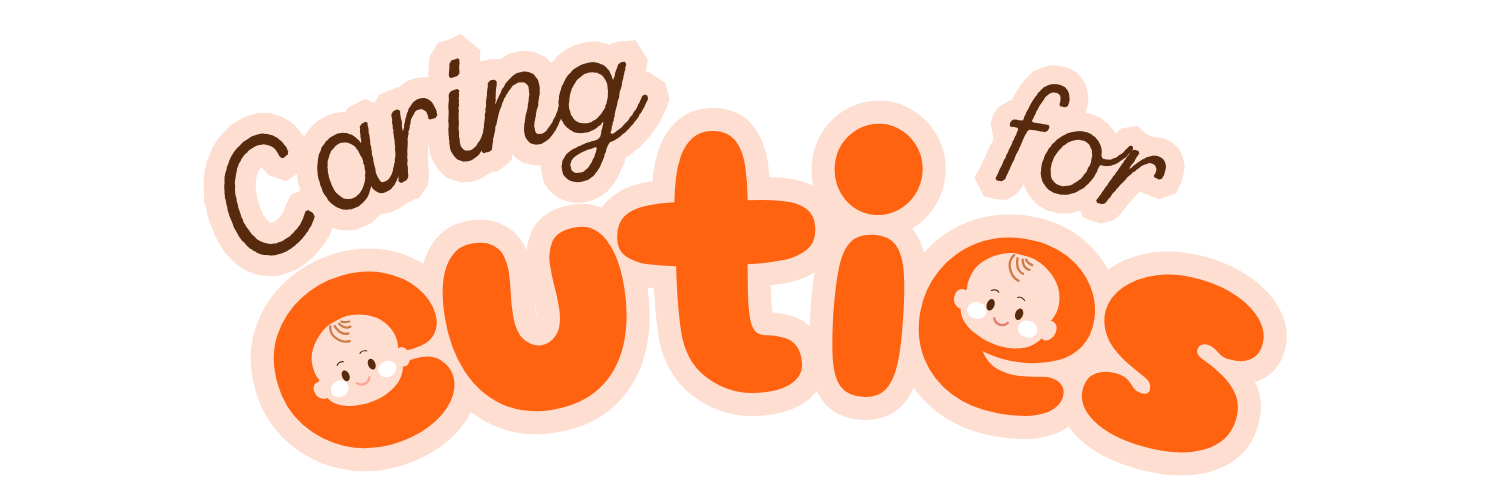What are the most common teething symptoms parents should watch for? When can we expect our baby’s first teeth? Knowing about baby teething is key to caring for your little one during this big milestone.

As a parent, spotting teething symptoms is vital. It helps you comfort and soothe your baby. The first teeth usually come in between 6 to 12 months. But, baby teething can start sooner or later than that.
Key Takeaways
- Understanding baby teething is key to the best care.
- Spotting teething symptoms is important for your baby’s comfort.
- The first teeth usually appear between 6 to 12 months.
- Baby teething can happen earlier or later than expected.
- Knowing teething symptoms helps in caring for your baby.
- Be ready to comfort and soothe your baby during baby teething.
Baby Teething: Article Breakdown in 10 Minutes
Understanding the Baby Teething Process
The teething process is a big step for babies, marking the start of their first teeth. It can be tough for them, leading to irritability, drooling, and sore gums. Knowing what happens during teething helps parents understand their baby’s discomfort.
Studies show teething is a complex process where teeth come out through the gums. This can hurt, making babies uncomfortable and restless. Parents look for ways to ease their baby’s pain.
What Happens During Teething
Babies go through physical changes during teething, like swollen and sore gums. The coming tooth puts pressure on the gums, causing pain and fussiness. Sometimes, babies might also get a low fever, diarrhea, or a rash.
Why Teething Causes Discomfort
Teething is uncomfortable because of the pressure from the coming tooth. This pressure can cause inflammation, pain, and swelling. Babies become irritable and restless. They might also chew on things or cry a lot.

The Role of Development in Teething
Teething is a key part of a baby’s development, marking a big milestone. As babies grow, their teeth come in, helping them chew and digest food. It also helps them develop their jaw and facial muscles, important for speaking and eating.
Understanding teething and its effects on babies is key for parents. Using teething remedies like toys or gels can help ease their discomfort. This makes the teething process easier for both babies and parents.
| Teething Remedies | Description |
|---|---|
| Teething Toys | Soft, chewable toys that provide relief from sore gums |
| Teething Gels | Topical gels that numb the gums and provide pain relief |
| Cold Compresses | Cold, wet cloths that reduce swelling and ease pain |
Your Complete Baby Teething Timeline
The baby teething timeline starts around 6 months, when the first teeth appear. This can go on until the child is about 3 years old. Knowing this timeline helps parents care for their baby during this time.
Here’s a basic guide to the baby teething timeline:
- Lower front teeth (incisors): 6-10 months
- Upper front teeth (incisors): 8-12 months
- Lower molars: 12-16 months
- Upper molars: 16-20 months
- Canines: 16-22 months
- Second molars: 22-28 months
Remember, every baby is unique, and their teething timeline can differ. But this guide helps parents keep track of their baby’s teething progress.

Knowing the baby teething timeline helps parents prepare for the teething journey. With the right care, babies can have a smooth teething experience and grow healthy teeth and gums.
| Age | Teeth |
|---|---|
| 6-10 months | Lower front teeth (incisors) |
| 8-12 months | Upper front teeth (incisors) |
| 12-16 months | Lower molars |
| 16-20 months | Upper molars |
| 16-22 months | Canines |
| 22-28 months | Second molars |
Common Signs and Symptoms of Baby Teething
Teething can be tough on babies, and knowing the signs helps parents offer relief. Common signs include drooling, irritability, and swollen gums. Babies might also act fussier and eat less when they’re teething.
Some key signs to watch for include:
- Drooling and excessive saliva production
- Irritability and fussiness
- Loss of appetite and refusal to feed
- Swollen and tender gums
It’s important to know the difference between normal teething signs and serious issues. If a baby has a fever, trouble breathing, or other severe symptoms, get medical help right away. Recognizing teething symptoms helps parents comfort their babies during this time.

Knowing about teething symptoms is key to helping your baby feel better. By understanding the physical and behavioral changes, parents can ease their baby’s discomfort. This makes the teething process smoother for everyone.
| Teething Symptom | Description |
|---|---|
| Drooling | Excessive saliva production |
| Irritability | Fussiness and restlessness |
| Loss of Appetite | Refusal to feed or decreased interest in food |
The Order of Tooth Emergence: What to Expect
Knowing the teething order helps parents get ready for their baby’s growth. The first teeth to come out are the lower front ones. Then, the upper front teeth follow, and lastly, the molars. This journey starts around six months and ends when the baby is three years old.
Babies often feel baby teething pain during this time. To ease it, try rubbing their gums with a clean finger or give them a teething toy. It’s also key to know when each tooth should appear. This way, you can keep an eye on your baby’s progress and get help if needed.
Some important milestones in the teething order are:
- Lower front teeth: 6-10 months
- Upper front teeth: 8-12 months
- Molars: 12-16 months

By knowing the teething order and how to handle baby teething pain, parents can make this big step easier for their baby. They can help their little one feel more comfortable and supported.
Effective Solutions for Baby Teething Pain
Parents have many ways to ease baby teething pain. You can choose from medical, natural, and professional treatments. Knowing the options helps you pick the best for your baby.
Medical options like acetaminophen and ibuprofen can help with pain. But, always talk to a doctor before giving any medicine. Natural solutions like cold teething rings and frozen washcloths are also good. They can offer relief without the risk of side effects.
Medical Relief Options
- Acetaminophen
- Ibuprofen
Natural Remedies and Solutions
- Cold teething rings
- Frozen washcloths
- Teething tablets
For really bad pain, there are professional treatments like topical anesthetics. Always check with a doctor to find the best treatment for your baby. By looking into all the options, you can help your baby feel better.
| Teething Remedy | Description |
|---|---|
| Acetaminophen | A medical relief option to reduce pain and inflammation |
| Cold Teething Rings | A natural remedy to provide relief for baby teething pain |
| Teething Tablets | A natural remedy to provide relief for baby teething pain |
Safe Teething Toys and Tools
Teething toys are a big help when your baby is teething. It’s key to pick toys that are safe and strong. Look for BPA-free and non-toxic ones that can handle chewing. Teething rings, teethers, and pacifiers are good choices.
There are also natural teething remedies that can help. Frozen fruits and veggies, like peas or carrots, can soothe your baby. A cold, wet washcloth can also numb their gums.
Here are some tips for picking and using teething toys and natural teething remedies:
- Always watch your baby when they use them
- Pick toys that are easy to clean
- Stay away from toys with small parts or sharp edges
- Try different natural teething remedies to see what works best
By following these tips and choosing safe teething toys and natural teething remedies, you can make your baby’s teething easier.
| Teething Toy | Benefits |
|---|---|
| Teething Rings | Easy to clean, durable, and can be refrigerated for added relief |
| Teethers | Come in a variety of textures and colors, can be filled with water or gel for added cooling |
| Pacifiers | Can help soothe a fussy baby, come in a variety of sizes and materials |
Dental Care During the Teething Phase
Proper dental care is key during teething to keep your baby’s teeth and gums healthy. As a parent, starting good oral hygiene early is vital. Teething gel can help ease your baby’s sore gums.
Start by cleaning your baby’s gums with a soft cloth. Introduce a toothbrush early to remove bacteria and plaque. This helps prevent tooth decay and other oral health problems. Make sure to book your baby’s first dental visit by six months of their first tooth or by their first birthday.
Early Oral Hygiene Tips
- Use a soft cloth to clean your baby’s gums
- Introduce a toothbrush at an early age
- Use a small amount of toothpaste
When to Schedule First Dental Visit
The first dental visit is a chance for your dentist to check your baby’s teeth. They can also suggest teething gel for sore gums.
By following these tips and regular dental visits, your baby will learn good oral hygiene. This ensures a healthy, happy smile. Always prioritize your baby’s dental care and seek advice if you’re unsure.
| Age | Dental Care Tips |
|---|---|
| 0-6 months | Clean gums with a soft cloth |
| 6-12 months | Introduce a toothbrush and toothpaste |
| 1-2 years | Schedule first dental visit |
Myths and Facts About Baby Teething
There are many myths and facts about baby teething that parents need to know. It can be hard to tell what’s true and what’s not, with so much information online. One myth is that teething causes fever, but studies show this isn’t true.
Teething can make babies uncomfortable and cranky, but it doesn’t directly cause fever. Another myth is that giving medication is the best way to ease teething pain. But, the American Academy of Pediatrics suggests using a teething necklace or cold teething toys instead.
These methods are safer and work better in the long run. It’s important to trust reliable sources and talk to a healthcare professional for advice.
- Teething usually starts around 6 months, but can start as early as 3 months or as late as 12 months.
- The first teeth to come in are usually the lower front teeth, followed by the upper front teeth.
- Teething can cause drooling, gum swelling, and irritability, but it’s not a cause for worry.
By knowing the myths and facts about baby teething, parents can make better choices for their babies. Always talk to a healthcare professional if you have any concerns or questions about your baby’s teething.
Nutrition and Diet During Teething
When your baby is teething, it’s key to pay attention to their nutrition and diet. A balanced diet full of vitamins and minerals can ease teething pain and boost their health.
Good nutrition and diet help your baby’s teeth grow strong. Foods like cold teething toys or frozen fruits can also help with teething pain. It’s important to start solid foods around six months to ensure they get enough nutrients.
Here are some tips for a healthy nutrition and diet during baby teething:
- Offer a variety of solid foods, including fruits, vegetables, and proteins
- Avoid giving the baby too many sugary or acidic foods, which can exacerbate teething pain
- Keep the baby hydrated by giving them plenty of breast milk or formula
By focusing on a healthy nutrition and diet during baby teething, parents can help their baby get through this phase with less pain. It also supports their overall health and growth.
Conclusion: Supporting Your Baby Through the Teething Journey
As your baby goes through teething, they need your care and support. Every baby teething differently, so be patient and watch for their needs. Knowing the signs and having good remedies can ease their pain.
Don’t be shy to talk to your pediatrician or dentist about teething. They can give you advice tailored to your baby. With the right care, your baby can get through this milestone smoothly.
The baby teething 101 tips in this guide are a good start. But remember, every baby is unique. Listen to your child and trust your parenting instincts. You and your baby can get through this teething phase together, feeling confident and caring for each other.
FAQ
What are the common signs and symptoms of baby teething?
Signs of baby teething include drooling and irritability. Babies might also bite or chew on objects. Swollen or red gums and loss of appetite are other signs.
When can parents expect the first tooth to emerge?
Babies usually get their first tooth between 4 to 7 months. But, some might start teething as early as 3 months or as late as 12 months.
How can parents soothe a teething baby?
To soothe a teething baby, use a cold teething ring. You can also massage the gums with a clean finger. Frozen fruits or vegetables are good for chewing.
Parents can try over-the-counter pain relievers or natural remedies like chamomile tea or clove oil.
What are the different stages of the teething process?
The teething process has stages. The first teeth, the lower front teeth, come out around 6 months. Then, the upper front teeth, molars, and canines follow.
The full set of 20 primary teeth is usually complete by 2 or 3 years old.
When should parents schedule the first dental visit for their baby?
The American Academy of Pediatric Dentistry suggests the first dental visit within 6 months of the first tooth. Or by the child’s first birthday, whichever comes first.
Are teething tablets and gels safe for babies?
Teething tablets and gels with benzocaine or belladonna are a concern. The FDA has warned about their use. Always check with a pediatrician before using any teething remedies.
Consider safer options like cold teething rings or frozen fruits and vegetables.
Can teething cause a fever or diarrhea in babies?
Teething can cause some discomfort and mild symptoms like drooling or irritability. But, it’s not usually linked to fever or diarrhea. If a baby has these symptoms, it might be another condition.
Parents should consult a healthcare provider.
Are teething necklaces safe for babies?
Teething necklaces, including those made with amber, are marketed as natural pain relief. But, there’s no scientific proof they work. They also pose a choking hazard for babies.
The American Academy of Pediatrics advises against using teething necklaces and jewelry for babies.





